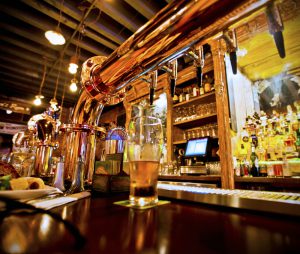A short history of English pub signage: Third in a SmartSign blog series on famous signs and their origins

The English pub is quintessentially English, like roast beef, tea and the Tudor rose– even the smallest village in the English countryside has a pub. (The oldest English pub still in existence, Ye Old Fighting Cocks, was founded in 795.) And the pub sign, universally part of the pub’s appeal, has an unusual origin of its own.
The ancestor of the pub was first introduced to England by the Romans, who were the first to build paved roads through Britain. The Romans liked to drink, and so built the first taverns in Britain. Taverns, naturally, need signs. From the ruins of Pompeii, we know that Roman taverns used the vine leaves of Bacchus, god of wine, to identify themselves.
The Roman Empire didn’t last, and the Roman legions left Britain for good in 410. But their taverns stayed, and evolved into the English pub. Gradually, locally-brewed ale replaced imported wine as the drink of choice as the imperial transport links broke down. By the Middle Ages, ale had become one of the most common drinks for the people of England, and a key part of the medieval diet.
By The 12th century, it was common for pubs to have proper names. Most pubs during this era indicated their name with an illustration above the entrance. As most English could neither read nor write, it became standard practice to include a colorful sign over the entrance which doubled as the pub’s name.
Government regulations also played a role. Because ale was so important to the English diet, the kings of England sought to regulate ale production to keep unscrupulous brewers from adulterating their ale. At the time, ale was still exclusively brewed and served on-site. King Henry III began appointing ale inspectors in 1266. These inspectors would go from pub to pub testing the quality and strength of the ale, fining those who broke the law. By 1393, King Richard II made it mandatory for pubs to have a sign, so his ale inspectors could identify where ale was served. And in 1431, another law was passed which gave ale inspectors the right to seize the ale of any pub landlord who refused to put up a sign. (William Shakespeare’s father, John Shakespeare, was one of these ale inspectors.)
As pubs proliferated, so did the names and the signs. Sometimes the name and its accompanying sign was descriptive: Ye Olde Fighting Cocks for its cockfights, or the Red House for its color. Other times it referenced symbols—the Cross Keys to represent St. Peter, or the White Hart for the livery badge of King Richard II. And now, even in an era of modern branding, the tradition has kept on as pub chains have adopted the signage and habits of their predecessors.
